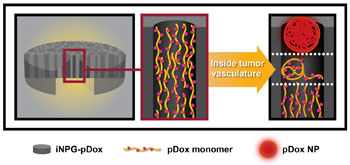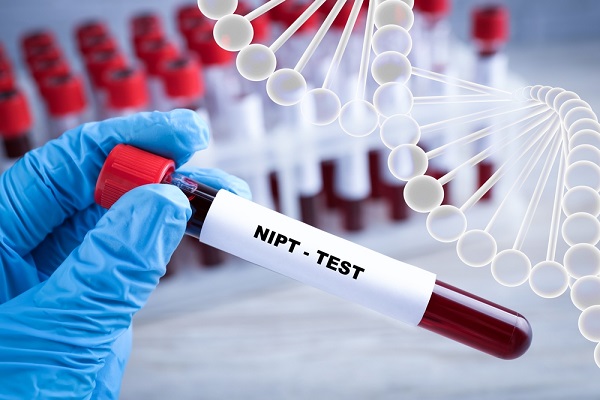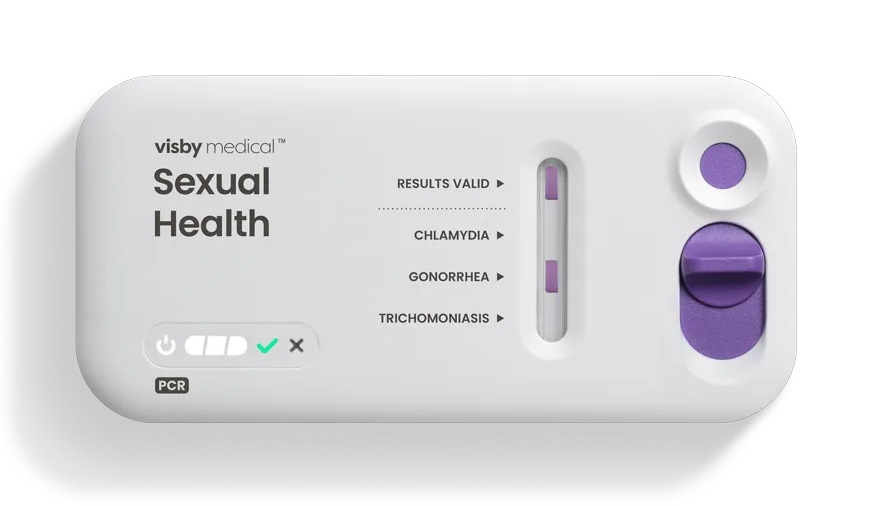Nanoparticle Drug Delivery Avoids Cancer Cells' Protein Pumps
|
By LabMedica International staff writers Posted on 27 Mar 2016 |

Image: The iNPG drug delivery process (Photo courtesy of Houston Methodist Research Institute).
A novel nanoparticle delivery system avoids excretion by cancer cells' protein pumps and transports the highly toxic anti-cancer drug doxorubicin (Dox) directly into the nuclei of cancer cells without causing damage to normal tissues or cells.
Although in use for more than 40 years as a primary chemotherapy drug, Dox is known to cause serious heart problems. To prevent these, doctors may limit the amount of Dox given to each patient so that the total amount a patient receives over her or his entire lifetime is 550 milligrams per square meter, or less. Furthermore, the necessity to stop treatment to protect the patient from heart disease may diminish the usefulness of Dox in treating cancer.
A team of investigators at the Houston Methodist Research Institute (TX, USA) reported developing a method to avoid the toxic effects of Dox while delivering it in high concentrations to its target inside tumor cells.
In the March 14, 2016, online edition of the journal Nature Biotechnology they described development of an injectable nanoparticle generator (iNPG), a micrometer-sized porous silicon-based particle loaded with a doxorubicin-poly(L-glutamic acid) conjugate (pDox) that was created using a pH-sensitive cleavable linker. These iNPG particles were injected into mice, and accumulated at tumors due to natural tropism and to the enhanced vascular dynamics at the tumor sites.
Once inside the cancer cell, the acidic pH in the vicinity of the nucleus released the drug conjugate from the nanoparticles. Upon release from iNPG, pDox spontaneously formed nanometer-sized particles in aqueous solution. These pDox nanoparticles were transported to the perinuclear region of the cell and cleaved to free the Dox, which killed the cell. The direct delivery to the nucleus avoided excretion of the Dox by cellular drug efflux protein pumps.
Compared to treatment with its individual components or with current therapeutic formulations, iNPG-pDox showed enhanced efficacy in MDA-MB-231 and 4T1 mouse models of metastatic breast cancer, including functional cures in 40%–50% of treated mice. These animals remained in remission for at least eight months, which is equivalent to about 24 years of long-term survival following metastatic disease for humans.
"This may sound like science fiction, like we have penetrated and destroyed the Death Star, but what we discovered is transformational. We invented a method that actually makes the nanoparticles inside the cancer and releases the drug particles at the site of the cellular nucleus. With this injectable nanoparticle generator, we were able to do what standard chemotherapy drugs, vaccines, radiation, and other nanoparticles have all failed to do," said contributing author Dr. Mauro Ferrari, CEO of the Houston Methodist Research Institute. "If this research bears out in humans, and we see even a fraction of this survival time, we are still talking about dramatically extending life for many years. That is essentially providing a cure in a patient population that is now being told there is none."
Related Links:
Houston Methodist Research Institute
Although in use for more than 40 years as a primary chemotherapy drug, Dox is known to cause serious heart problems. To prevent these, doctors may limit the amount of Dox given to each patient so that the total amount a patient receives over her or his entire lifetime is 550 milligrams per square meter, or less. Furthermore, the necessity to stop treatment to protect the patient from heart disease may diminish the usefulness of Dox in treating cancer.
A team of investigators at the Houston Methodist Research Institute (TX, USA) reported developing a method to avoid the toxic effects of Dox while delivering it in high concentrations to its target inside tumor cells.
In the March 14, 2016, online edition of the journal Nature Biotechnology they described development of an injectable nanoparticle generator (iNPG), a micrometer-sized porous silicon-based particle loaded with a doxorubicin-poly(L-glutamic acid) conjugate (pDox) that was created using a pH-sensitive cleavable linker. These iNPG particles were injected into mice, and accumulated at tumors due to natural tropism and to the enhanced vascular dynamics at the tumor sites.
Once inside the cancer cell, the acidic pH in the vicinity of the nucleus released the drug conjugate from the nanoparticles. Upon release from iNPG, pDox spontaneously formed nanometer-sized particles in aqueous solution. These pDox nanoparticles were transported to the perinuclear region of the cell and cleaved to free the Dox, which killed the cell. The direct delivery to the nucleus avoided excretion of the Dox by cellular drug efflux protein pumps.
Compared to treatment with its individual components or with current therapeutic formulations, iNPG-pDox showed enhanced efficacy in MDA-MB-231 and 4T1 mouse models of metastatic breast cancer, including functional cures in 40%–50% of treated mice. These animals remained in remission for at least eight months, which is equivalent to about 24 years of long-term survival following metastatic disease for humans.
"This may sound like science fiction, like we have penetrated and destroyed the Death Star, but what we discovered is transformational. We invented a method that actually makes the nanoparticles inside the cancer and releases the drug particles at the site of the cellular nucleus. With this injectable nanoparticle generator, we were able to do what standard chemotherapy drugs, vaccines, radiation, and other nanoparticles have all failed to do," said contributing author Dr. Mauro Ferrari, CEO of the Houston Methodist Research Institute. "If this research bears out in humans, and we see even a fraction of this survival time, we are still talking about dramatically extending life for many years. That is essentially providing a cure in a patient population that is now being told there is none."
Related Links:
Houston Methodist Research Institute
Latest BioResearch News
- Genome Analysis Predicts Likelihood of Neurodisability in Oxygen-Deprived Newborns
- Gene Panel Predicts Disease Progession for Patients with B-cell Lymphoma
- New Method Simplifies Preparation of Tumor Genomic DNA Libraries
- New Tool Developed for Diagnosis of Chronic HBV Infection
- Panel of Genetic Loci Accurately Predicts Risk of Developing Gout
- Disrupted TGFB Signaling Linked to Increased Cancer-Related Bacteria
- Gene Fusion Protein Proposed as Prostate Cancer Biomarker
- NIV Test to Diagnose and Monitor Vascular Complications in Diabetes
- Semen Exosome MicroRNA Proves Biomarker for Prostate Cancer
- Genetic Loci Link Plasma Lipid Levels to CVD Risk
- Newly Identified Gene Network Aids in Early Diagnosis of Autism Spectrum Disorder
- Link Confirmed between Living in Poverty and Developing Diseases
- Genomic Study Identifies Kidney Disease Loci in Type I Diabetes Patients
- Liquid Biopsy More Effective for Analyzing Tumor Drug Resistance Mutations
- New Liquid Biopsy Assay Reveals Host-Pathogen Interactions
- Method Developed for Enriching Trophoblast Population in Samples
Channels
Clinical Chemistry
view channel
New ADLM Guidance Provides Expert Recommendations on Clinical Testing For Respiratory Viral Infections
Respiratory tract infections, predominantly caused by viral pathogens, are a common reason for healthcare visits. Accurate and swift diagnosis of these infections is essential for optimal patient management.... Read more
3D Printed Point-Of-Care Mass Spectrometer Outperforms State-Of-The-Art Models
Mass spectrometry is a precise technique for identifying the chemical components of a sample and has significant potential for monitoring chronic illness health states, such as measuring hormone levels... Read more.jpg)
POC Biomedical Test Spins Water Droplet Using Sound Waves for Cancer Detection
Exosomes, tiny cellular bioparticles carrying a specific set of proteins, lipids, and genetic materials, play a crucial role in cell communication and hold promise for non-invasive diagnostics.... Read more
Highly Reliable Cell-Based Assay Enables Accurate Diagnosis of Endocrine Diseases
The conventional methods for measuring free cortisol, the body's stress hormone, from blood or saliva are quite demanding and require sample processing. The most common method, therefore, involves collecting... Read moreMolecular Diagnostics
view channel.tmb-0945x532.jpg)
Ultra-Sensitive Blood Test Predicts Breast Cancer Recurrence Months or Even Years before Relapse
Breast cancer cells can linger in the body after surgery and other treatments, sometimes in such low quantities that follow-up scans fail to detect them. These cells can cause a recurrence of breast cancer... Read more
Prenatal Testing Offers Window for Finding Mother’s Cancer Risk
Harmful variants in the BRCA1 gene significantly increase an individual's lifetime risk of developing breast, ovarian, and pancreatic cancers, yet most carriers are unaware of their status.... Read moreHematology
view channel
Next Generation Instrument Screens for Hemoglobin Disorders in Newborns
Hemoglobinopathies, the most widespread inherited conditions globally, affect about 7% of the population as carriers, with 2.7% of newborns being born with these conditions. The spectrum of clinical manifestations... Read more
First 4-in-1 Nucleic Acid Test for Arbovirus Screening to Reduce Risk of Transfusion-Transmitted Infections
Arboviruses represent an emerging global health threat, exacerbated by climate change and increased international travel that is facilitating their spread across new regions. Chikungunya, dengue, West... Read more
POC Finger-Prick Blood Test Determines Risk of Neutropenic Sepsis in Patients Undergoing Chemotherapy
Neutropenia, a decrease in neutrophils (a type of white blood cell crucial for fighting infections), is a frequent side effect of certain cancer treatments. This condition elevates the risk of infections,... Read more
First Affordable and Rapid Test for Beta Thalassemia Demonstrates 99% Diagnostic Accuracy
Hemoglobin disorders rank as some of the most prevalent monogenic diseases globally. Among various hemoglobin disorders, beta thalassemia, a hereditary blood disorder, affects about 1.5% of the world's... Read moreImmunology
view channel.jpg)
AI Tool Predicts Cancer Patients’ Response to Immunotherapy
Immune checkpoint inhibitors are a form of immunotherapy drug that enables immune cells to target and destroy cancer cells. At present, the Food and Drug Administration has approved two predictive biomarkers... Read more
Molecular Profiling Improves Diagnosis for Children with High Risk Cancers
Cancer remains the leading cause of disease-related death among children in most developed nations, and approximately one-fourth of these patients are diagnosed with aggressive, high-risk, or relapsed... Read moreMicrobiology
view channel
POC STI Test Shortens Time from ED Arrival to Test Results
In a 2024 sexually transmitted infections (STIs) surveillance report by the World Health Organization (WHO), over 2.5 million cases were recorded, alongside a rise in the inappropriate use of antibiotics... Read more
Integrated Solution Ushers New Era of Automated Tuberculosis Testing
Tuberculosis (TB) is responsible for 1.3 million deaths every year, positioning it as one of the top killers globally due to a single infectious agent. In 2022, around 10.6 million people were diagnosed... Read more
Automated Sepsis Test System Enables Rapid Diagnosis for Patients with Severe Bloodstream Infections
Sepsis affects up to 50 million people globally each year, with bacteraemia, formerly known as blood poisoning, being a major cause. In the United States alone, approximately two million individuals are... Read moreEnhanced Rapid Syndromic Molecular Diagnostic Solution Detects Broad Range of Infectious Diseases
GenMark Diagnostics (Carlsbad, CA, USA), a member of the Roche Group (Basel, Switzerland), has rebranded its ePlex® system as the cobas eplex system. This rebranding under the globally renowned cobas name... Read morePathology
view channel
AI Tool Detects Tiny Protein Clumps in Microscopy Images in Real-Time
Over 55 million individuals worldwide suffer from dementia-related diseases like Alzheimer's and Parkinson's. These conditions are caused by the clumping together of the smallest building blocks in the... Read more
New Tool Enables Better Classification of Inherited Disease-Causing Variants
Whole genome and exome sequencing are increasingly available for clinical research, aiding in the detection of inherited genetic variants that may cause various diseases. The American College of Medical... Read more
Groundbreaking CRISPR Screen Technology Rapidly Determines Disease Mechanism from Tissues
Thanks to over a decade of advancements in human genetics, scientists have compiled extensive lists of genetic variations linked to a wide array of human diseases. However, understanding how a gene contributes... Read moreTechnology
view channel
Microneedle Patch Detects Skin Cancer Early
Wearable bioelectronics has emerged as a significant innovation in healthcare, especially in the field of biosensing, providing a new method to monitor individual health for both diagnostic and therapeutic purposes.... Read more
New Diagnostic System Achieves PCR Testing Accuracy
While PCR tests are the gold standard of accuracy for virology testing, they come with limitations such as complexity, the need for skilled lab operators, and longer result times. They also require complex... Read moreIndustry
view channel
Roche and Hitachi High-Tech Extend 46-Year Partnership for Breakthroughs in Diagnostic Testing
Roche (Basel, Switzerland) and Hitachi High-Tech (Tokyo, Japan) have renewed their collaboration agreement, committing to a further 10 years of partnership. This extension brings together their long-standing... Read more
Danaher and Johns Hopkins University Collaborate to Improve Neurological Diagnosis
Unlike severe traumatic brain injury (TBI), mild TBI often does not show clear correlations with abnormalities detected through head computed tomography (CT) scans. Consequently, there is a pressing need... Read more
Beckman Coulter and MeMed Expand Host Immune Response Diagnostics Partnership
Beckman Coulter Diagnostics (Brea, CA, USA) and MeMed BV (Haifa, Israel) have expanded their host immune response diagnostics partnership. Beckman Coulter is now an authorized distributor of the MeMed... Read more_1.jpg)











_2.jpeg)


.jpg)



